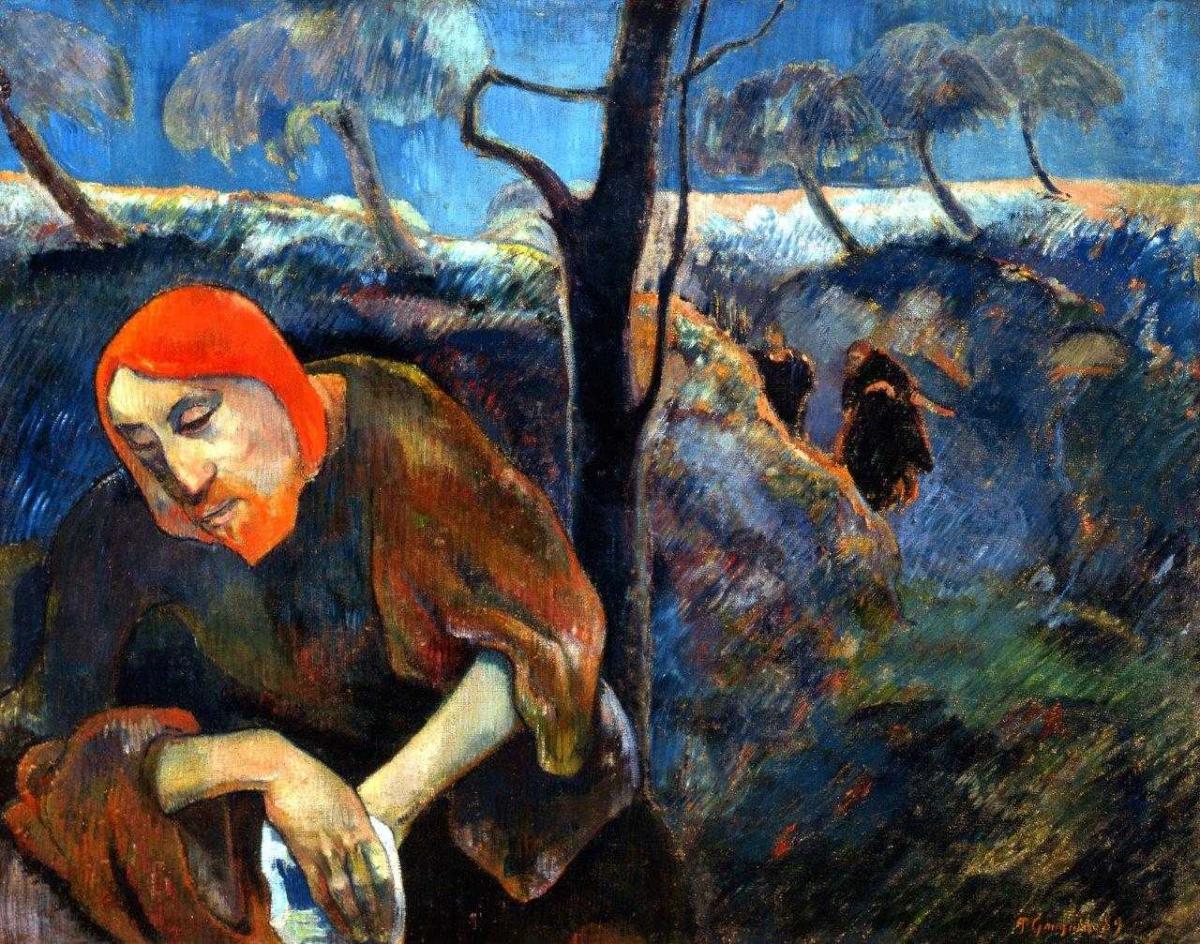
As a painter, especially in his early years, Gauguin could be remarkably gauche. Given a different chain of events, who knows, he might have founded the Gauche movement in painting, though it’s possible he would never have been able to recognise his own talent: tragically, he did not possess the self-awareness to see how startlingly and innovatively gauche his paintings were.
Instead, having an entirely atrophied sense of the ridiculous, especially as regarded his own person, Gauguin did not flinch from self-depictions of the painfully self-pitying variety, masterfully gauche in execution. In one picture shown at the National Gallery recently, he was even crass enough to portray himself as Jesus on the night before the crucifixion. It was one of those moments in a career when you get the full measure of an artist’s ego.
An identification with Jesus is a common affliction with artists. The moment came later in the case of John Lennon. It took meeting and falling in love with an actual artist to get the erstwhile mop top to insist, over and over again in interviews, that he was an ‘artist’ too, and to sing ‘The way things are going / They’re gonna crucify me.’ What hell it must have been for the working-class hero turned conceptual art connoisseur to lie around in that bag, but we all have our cross to bear, eh, John?
I digress. Did I mention that in his self-depiction as the ‘man of sorrows,’ Gauguin gave himself red hair? I reckon he borrowed that idea from Bosch. Here is my evidence for this stunning assertion:

Frankly, the red hair is as much a mystery as the spiky gimp’s dog collar one of his tormentors is wearing, but hey, don’t complain, this is all remarkably restrained for Bosch.
Now Gauguin’s point is subtle, but unmistakable. It is drawn from every self-pitying tortured artist’s armoury of complaints. A translation into actual words would go something like this:
“I am mocked by lesser mortals, hence my obscurity and lack of success, as a consequence of which I shall die a martyr, starved in a garret, no, sleepless in Gethsemane, living on nothing more than a sense of my own wronged superiority, a bit like my good friend Van Gogh. I cannot succeed. I am cruelly rejected by a corrupt and unappreciative civilisation. Just like Van Gogh. Did I mention, a mate of mine? Another long-suffering innocent. Come to think of it, he also has red hair. In this self-portrait I partly identify with the Dutchman. That’s Vincent, not Hieronymus. Okay, when I say ‘mate of mine’, he did come at me with a razor, and I have abandoned him to his fate, but suffering, it’s something we definitely have in common. I painted this scene on the Mount of Olives the year after we fell out. It was no picnic. Being mates with Vincent, I mean, not the Mount of Olives. The man was demented. I’ve sweated blood for him, I tell you. Just like Christ did. The way things are going, they’re gonna...”
And so on. When Gauguin finally escaped the corrupt civilisation of France it was to a corrupted paradise in the Pacific – corrupted, naturally enough, by the French. Gauguin, being French, made his own humble contribution to the corrupting process by passing his work off as being influenced by the local culture before the French had sanitised it. He was a busy self-dramatist to the bitter end. It was the closest he ever cared to come to self-awareness. Living in a hut whose name means roughly House of the Orgasm, Gauguin decorated the walls with soft porn images produced in distant Parisian studios and feasted his eyes on the nakedness of local teenagers. So far, so French. But this was not his self-perception, i.e. the derelict and debauched Dorian portrait incarnate, syphilitic sensualist of the south seas. No, his self-perception, as persistently repeated from one letter to the next, was something quite different and, if you will excuse the cliché, nobler. It was of himself as savage.
One can see why this might have appealed. The ‘savage’ label sells, after all, as much nowadays as it did then. Take the word savage and simply append X Fenty, it virtually mints money – there’s more gold in there than those nature-loving miners will ever find in the Amazon. The word sells clothes, in an oh-so counter-intuitive way. It sells perfume, which is equally unlikely if you think about it. My hunch is that the ad for Sauvage, a fragrance for men, derives some of its imagery from the following French definitions:
a) les animaux sauvages, meaning wild animals,
b) une région sauvage, meaning a wilderness, and
c) il est un peu sauvage, meaning he’s rather unsociable.
So, a) Johnny Depp [for it is he] drives out into the desert, passing a bison coming the opposite way; b) he arrives in the middle of nowhere, for reasons that will never become apparent, and c) he digs a hole and appears to drop a keepsake of some kind into it. Is he trying to forget? The look of satisfaction on his face after the keepsake has been buried suggests it is so. A less imaginative man would have joined the Foreign Legion, or maybe just chucked the keepsake in the nearest canal, but clearly this would have lacked the requisite noble savagery.
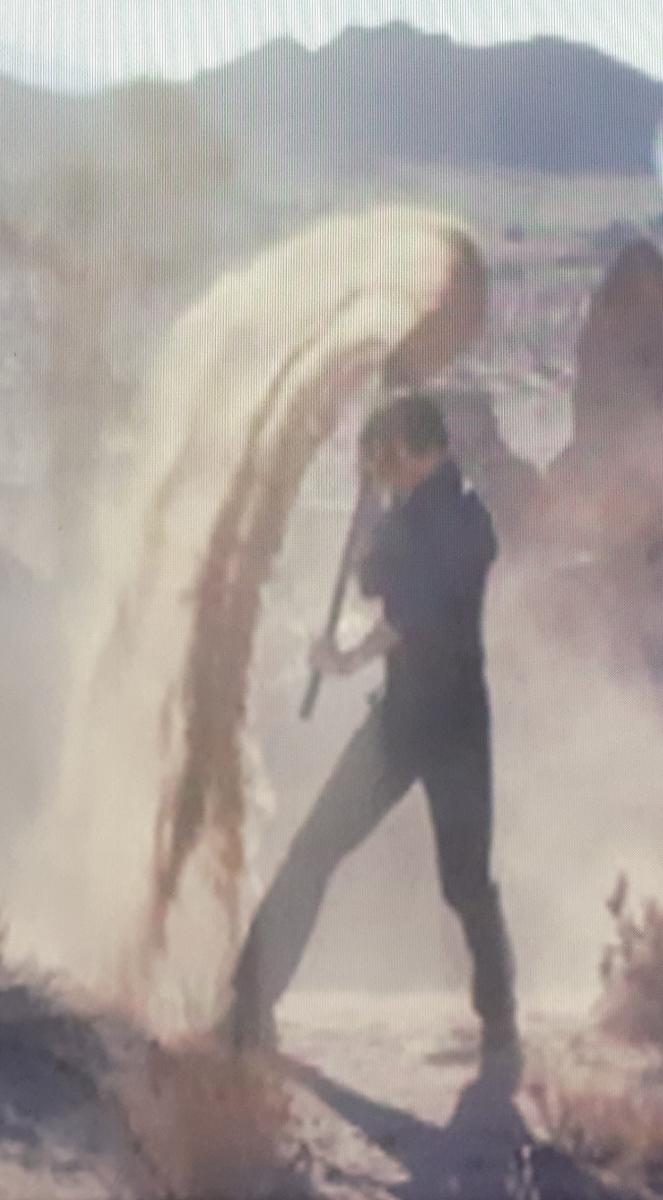
It’s a pity Roland Barthes cannot be here to help me with this advertisement. Surely anyone who has seen it shares my bafflement at its multi-layered semiology. However, I would suggest that the semiotic punctum - if I may abuse a term from Camera Lucida - is the way Depp digs his hole. He does it with such savage flourish, tossing a spade full of dirt over his shoulder in a way calculated to get most of it on himself. Surely, no ordinary person would toss dirt over himself like that, in such a self-defeating fashion... apart, maybe, from a working class Tory voter.
Forsooth, it is a mystery as profound as the hole is shallow, but my feeble attempt to emulate the great French theorist goes like this: Johnny Depp is an actor, and therefore has never had to clean himself up after a cack-handed attempt to dig a hole. Moreover, it is either his first try at digging such a hole, or – and this, I suspect, is the most likely explanation – how else was he to make the digging of a hole in the middle of nowhere, for reasons that would not become apparent, seem sufficiently virile? Yes, he may appear dumb to those more experienced in the task of hole-digging, but they have not made a fortune from being charismatic method actors. Leaving aside the fact that no real man ever dug a hole in this way, I submit that this ad speaks to the repressed savagery of an over-developed civilisation, and the perfect right of a real man to make a pointless gesture, unseen by anyone (excepting the millions viewing the advert) and then, afterwards, while cleaning himself up, grr, to douse his bestial body in the essence of an unwashed forest-dweller.
But then again, I could just be over-thinking it.
The small drawback for Gauguin was the slim basis for this self-portrayal. He had been a stock broker, but who doesn’t have something sordid in their past? More to the point, though, he had been born in France, but brought up in Peru, for reasons that I shall not go into as I have to get to the nub of this story. During his time in Peru, or else somewhat later when compelled to return to France, Gauguin decided that all the evidence – his aquiline nose, his eyes, his habit of wearing woollen hats with flaps over the ears, but most importantly the aquiline nose – pointed to Inca heritage. The small details of having been born somewhere else, and not to actual indigenous Peruvian parents, could not refute the obvious evidence of the nose – Gauguin was indubitably of Inca heritage. As surely as James Brown was half African-American and half native American, so that nose was a pre-Colombian relic. The more one looked at it, the more irrefutable it became. One imagines Gauguin spending hours staring at it in the mirror. Any mirror. You would probably not take him window-shopping, for fear he would ignore the merchandise, dismissing it as the trash of a civilisation devoted to ephemeral consumerism, and fixate on his nose reflected in the shop windows. The aquiline shape of his nose would then become the sole topic of conversation for the remainder of the afternoon because, not to put too fine a point on it, Gauguin had a nose fixation.
Some years ago, I myself was in Peru. It’s quite a claim, I know, but there was a time that I recklessly dumped carbon into the atmosphere for no better reason than to satisfy my idle curiosity. I was innocent back then, and yet I shall suffer for it one day, when my best suit gets so badly burnt, or drenched, in the apocalypse that I can no longer wear it to job interviews and I end up sleeping outside the mother of all parliaments, destitute. How will I afford frivolous trips to faraway Peru then? Evidently, I will not.
Anyway, suffice to say I have seen their roads, their lost cities, their irrigation systems and their foundations. Some of the latter the Spaniards had the good sense to preserve, having dismantled the rest of the building. They then built their own, inferior stuff on the top of these wonderfully solid and expertly carved blocks, which happened to withstand earthquakes.

The Incas, let me get to the point here, were no savages. Some might claim that the distinction of that epithet belongs more to the conquistadors, but who am I to present a damning case against the civilising mission of black Catholic Spain? Who was Gauguin, for that matter? Well, as a disgruntled Inca, maybe. But not as a savage. It was yet another case of wanting to have his cake and eat it, and we Brits all know the unholy mess that can get you into. Gauguin thought he was Inca, and yet he reprised the conquistador’s disdain for his supposed ancestors by deeming them savages.
I suppose no one will credit me with huge, ground-breaking insight if I say that Paul Gauguin was one f—ked-up sonofabitch, though to be honest that phrase begs the whole question – just whose bitch was he the f—ked-up son of? Was it the Virgin, or was it the Earth goddess otherwise known as Pachamama?
Perhaps at this juncture a small diversion into travel writing might be helpful. At the very least it will give me a welcome rest from trying to sound clever. But first, another picture, this time of the last supper that immediately preceded the agony in the garden:

I came across this less than masterful depiction in Cusco, once capital of the Inca empire, after sampling some very wholesome soup provided by a wizened peasant wearing a llama wool hat with ear flaps, who told me...
That’s enough travel writing for the time being. Given the state of the planet, it’ll soon be as outdated as letter-writing anyway. The painting, however, though no masterpiece, was of huge interest. It is the only thing I remember about the cathedral. In it, the disciples tilt their heads piously, either gazing at their Lord or heavenwards. Only Jesus and Judas look directly at the viewer. Judas, in case you were wondering, is the swarthy one on the wrong side of the table. The object he’s clutching, probably a bag containing thirty pieces of silver, is conclusive proof that he was corrupted by consumerism. In the versions by Perugino, Ghirlandaio and Vasari, he also sits on the viewer’s side of the table, but in Leonardo’s version he sits with the rest of them, with only the swarthy complexion to give him away. Leonardo was never one to observe conventions. I shall come back to this swarthiness anon.
The picture was painted in 1753 by Marcos Zapata, a Quechua artist, so this was (if you want to go along with Gauguin’s misconceptions regarding his conception) the work of ‘a savage’. Clearly, anyone who doted on a cute, fluffy rodent as a child (I confess, I did) would agree with this description of Zapata, for the punctum here is not the figure of Judas, nor that of the glowing Christ. The punctum is not even a human being. Lying plumb in the middle of the table and of the picture, it is a savagely mistreated example of Peruvian fauna that grabs our attention:
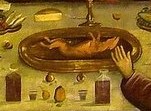
No, not a rat, though it could certainly pass for one under subdued lighting. In the local parlance, this is a cuy, or a rather scrawny-looking guinea pig, considered a delicacy in those parts. I have to say, either my guinea pigs were better-fed, or their outer fluffiness belied their inner scrawniness. One can’t imagine doting on a creature this scrawny, which probably explains why the Peruvians feel no qualms about slaughtering them.
This was not a delicacy they abandoned after the barbaric eighteenth century. To this very day, you can see guinea pigs roasted on spits in the public squares all over Peru. Many a tourist from gentler climes has wondered what these scrawny, runt-sized comestibles might be. Then, with one sickening jolt of recognition, they have been forced to leap the chasm from innocence to experience a second time. It was Tenpole Tudor who, charging dementedly around a cinema foyer, first posed the question “Who killed Bambi?” That question has haunted Western culture ever since. The answer is almost certainly “A native South American.”
And yet one man’s savage is another man’s member of the nobility. I remember being shocked to the core, on first setting foot in France, to find that the restaurants of Calais sold horsemeat. Worse still, the restaurateurs made no secret of the fact, advertising their wares on the public highway. Since then, the British have grown accustomed to the idea of horse flesh in their beef burgers, but back in the previous century a dead horse was supposed to be turned into glue, not knowingly eaten. Gauguin really was a savage, by dint of being French.
But these are trivial observations along the lines of the cultural differences between the nations. Nothing I have said so far comes close to the open-mindedness on this subject displayed by one of the greatest of all Frenchmen, Michel de Montaigne. He would not have shuddered at the sight of grilled pets, any more than he would, as a man of the world, have turned his nose up at horse glue. Montaigne was that rare thing in any age, a man without firm attachments to any customs or points of view. If you asked for his opinion on who killed Bambi, his answer would undoubtedly have been “What do I know?” I shall return to his essay Of Cannibals – from which I nicked my title and, in case you were expecting a disquisition on kinky modern sex practices, my theme – in the second part of these reflections, but for now I shall pick up where I left off and talk about Zapata.
One of the last members of the Cusco school (and it literally was a school, where he would have been taught by Spanish artists), Zapata was familiar with the routine. It is no surprise, for instance, that he places Judas on our side of the table. Leonardo was weird, it goes without saying, even Tintoretto had adhered to tradition on that one. Zapata knew very well the seating arrangements. He also knew that the Lord and his disciples ate bread and drank wine on the occasion, so why is it that some have claimed that in his version they are drinking chicha, a kind of beer brewed from maize and still drunk to this day? I’ve tried it, and I think I’ll stick to wine, if it’s all the same.
As a splash of local colour, this beverage seems harmless enough, until one remembers that the wine they drank at the Last Supper was the basis of the Eucharist or Holy Communion, which for Catholics involves an actual transformation of a wafer and a sip of Rioja into the body and blood of Christ. Somehow this seems to lose its solemnity if one tries the idea of a guinea pig and chicha instead. For one thing, chicha is a kind of murky brownish yellow, if memory serves me, while the flesh of the guinea pig is also roughly the same colour as the flesh of [ominous pause for effect here] Judas.
Actually, no, there is bread in the picture. Jesus is clutching a loaf of it. But on the matter of what should be drunk at Communion the Catholics were pretty clear. Would it be too cheap a comment to point out that believers consume (their preferred word is ‘ingest’) the body and blood of their Redeemer and that this sounds remarkably like cannibalism? It may not seem so to someone brought up to consider the mass a central part of their faith, and especially to one who takes scant interest in the arcane controversies over transubstantiation, but consider for a second the initial reaction of an Inca to all this. Just who looks ‘savage’ here, the conquered Inca who has to watch while his sophisticated culture is systematically obliterated and his people enslaved, or the blood-guzzling Spaniard providing his art lessons?
It’s hard to believe that this rank heresy, which leaps out at the viewer the moment they set eyes on the painting, has gone unnoticed in the cathedral for hundreds of years. It’s even harder to believe when one considers that guinea pigs were regularly sacrificed to Pachamama, the Inca earth goddess.
In fact, there is not need for alarm. I say this advisedly, as some persons of the Catholic persuasion have become very alarmed indeed about Pachamama, one might almost say panicky, as I shall explain in my next piece on this topic. For the moment, let me reiterate that the Incas, far from fitting the standard definition of ‘savages,’ had a fully worked out civilisation before the Spaniards turned up, with sophisticated building techniques, roads, irrigation, houses and a highly developed religion. Their conquerors could rip down their palaces and temples, they could even compel the Incas to labour on their cathedral, and they could make a local artist paint this Christian scene to hang on its wall, but none of this afforded them access to the Inca mind.
The persistence of the Inca culture is illustrated by an icon created by one of their artists. In neighbouring Bolivia, the Spaniards had found a hill at a place called Potosí that was so full of silver it supplied their empire for decades.

They then got the conquered Incas to mine the silver for them, before shipping it back to Spain in galleons. At some point the idea occurred to someone that the Virgin Mary protected what the foreigners referred to as the Cerro Rico (Spanish for Rich Hill), and from there an identification of the triangular silhouette of the hill with the Virgin herself led to this:
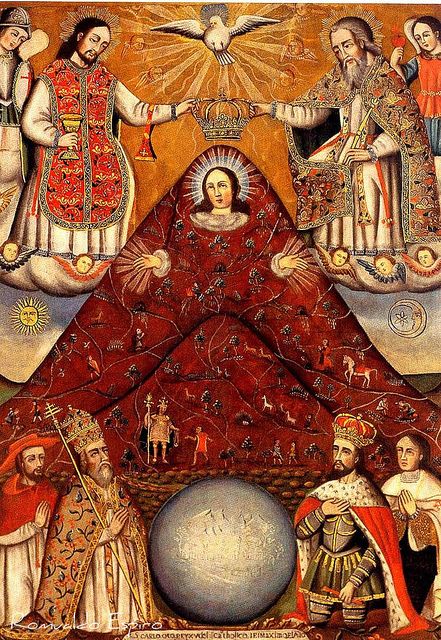
The picture is of a hill woman and its style is surrealism, long before Dali painted his first soft watch. Across the female hillside, out of scale, wander miniature men, horses, llamas, while the foreground is occupied by the bigwigs of state and clergy, and between them what appears to be a massive ball of solid silver, which amounts to considerably better earnings than Judas ever got.
In his Art of Colonial Latin America, Gauvin Alexander Bailey notes how syncretism meant that ‘the Andeans artists and their patrons united the Christian figure of the Virgin with elements of indigenous religion, fusing the two traditions into one.’ The end result is ‘a new, Andean Madonna.’ Quite literally, she became the Andes. Merging with the landscape itself, she was neither pre-Columbian nor Spanish.
Whoever came up with this syncretic hallucination – and it seems to have predated the Potosí image – it had the desired effect: it completely absorbed the imaginations of Peruvian artists. They easily transcended the crudity of the metallic mountain and dreamt up abstract, triangular Virgins, just as English artists had dreamt up stiff, cone-shaped images of Queen Elizabeth, also in imitation of the Biblical virgin. A Cusco Madonna was regal and yet benign. She could be very floral, yet earthy. At her base, and elsewhere, the sun and moon gave her additional universality, conveying the idea of twenty-four-hour protection to those who believed in her:
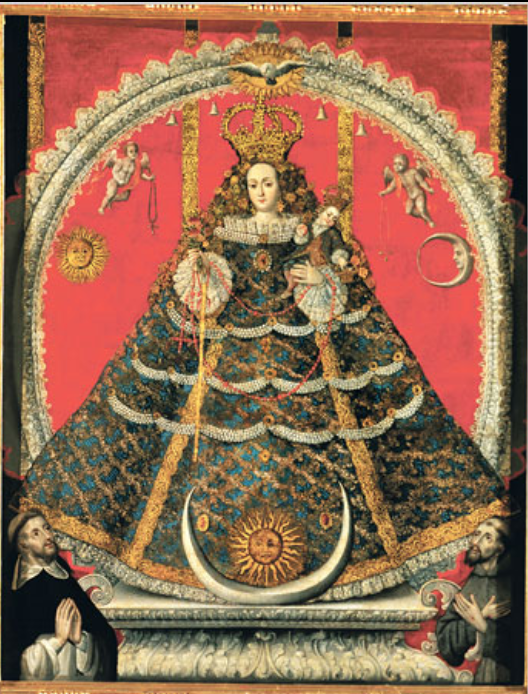
Her infant wore matching garb:
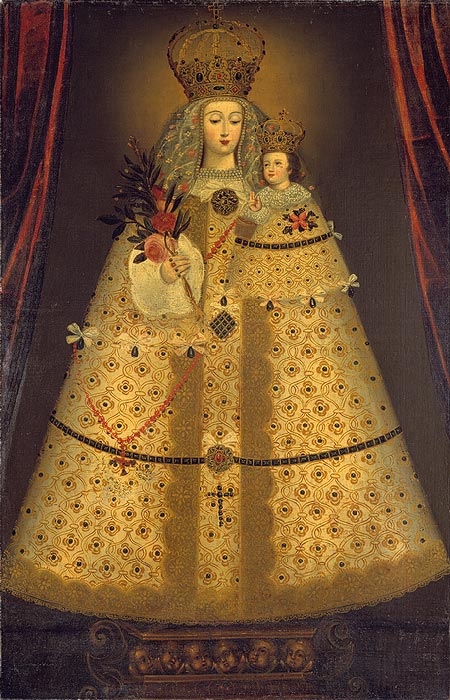
And at times could look oddly geometrical too:
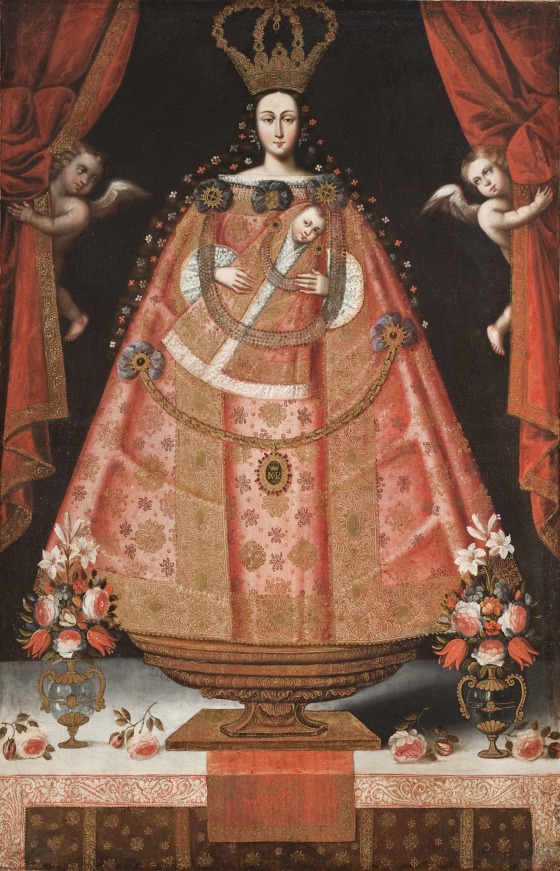
In this way, indigenous Peruvians managed to carry on worshipping their Andean goddess, not surreptitiously, but in plain sight.
Given such openness, Zapata’s tinkering with the menu for the Last Supper begins to look unremarkable. Let the Inca have what the Inca wants. The way the Spanish colonialists managed to get inside the heads of the vanquished was the opposite of brainwashing. They did it by letting the ‘savages’ think that really, deep down, they were still thinking what they’d always thought. In a Conservative general election campaign under the leadership of Michael Howard, the Tories once posed the arch rhetorical question “Are you thinking what we’re thinking?” The electorate replied with a resounding “Nope.” In the case of the Incas, the question was posed the other way around: “Are we thinking what you’re thinking?” and the Incas replied, “If you say so. A rose by any other name etc.”
Presumably, nobody much cared to get into the theological niceties of it all. The whole question of whether the bread and the wine of the Eucharist were literally the body and blood of Jesus depended on how one understood Christ’s assertion on the night that “this is my body… this is my blood.” Was Jesus being literal or just metaphorical?
Sometimes with these pesky conundrums you just have to put your foot down. Accordingly, in his 1968 Credo of the People of God, Pope Paul VI declared that any theological explanation of the doctrine of transubstantiation must uphold the twofold claim that, after the consecration, 1) Christ’s body and blood are really present, and 2) bread and wine are really absent, and that this presence and absence were real, and not merely in the mind of the believer.
Zapata might have used the same kind of argument if a fastidious Jesuit had ever questioned his orthodoxy: “Now don’t concern yourself, father,” he could have told him, shaking his head with an indulgent smile. “This is no heresy. Just as Pachamama is really absent when the Virgin is present, undergoing a miraculous alteration and ceasing to be a pagan goddess, so the guinea pig is but a figment of the imagination there to keep us savages happy. What’s that? Why is Judas so swarthy and the others so pale? I’d have thought it was obvious, father – Judas is a Peruvian.”







